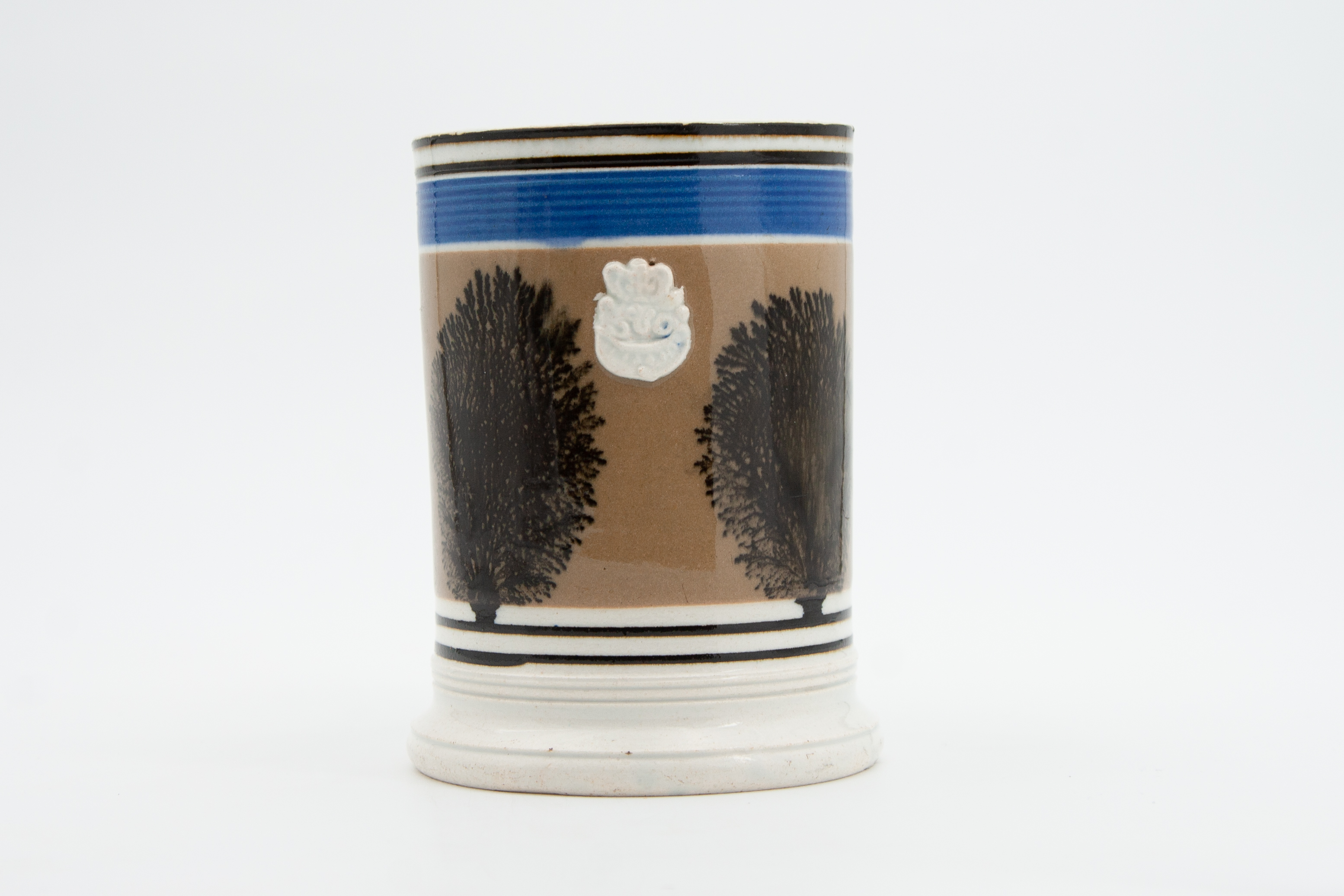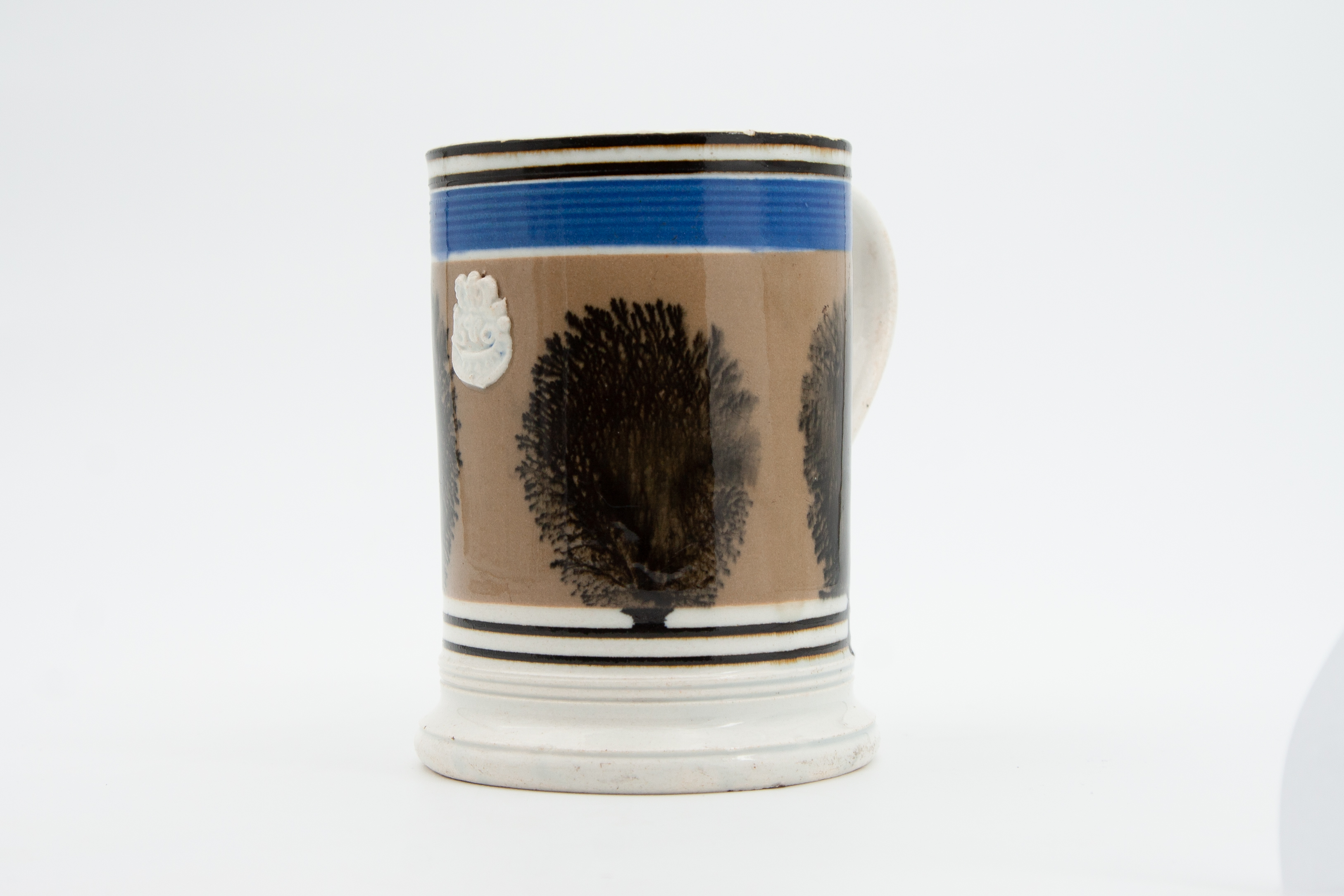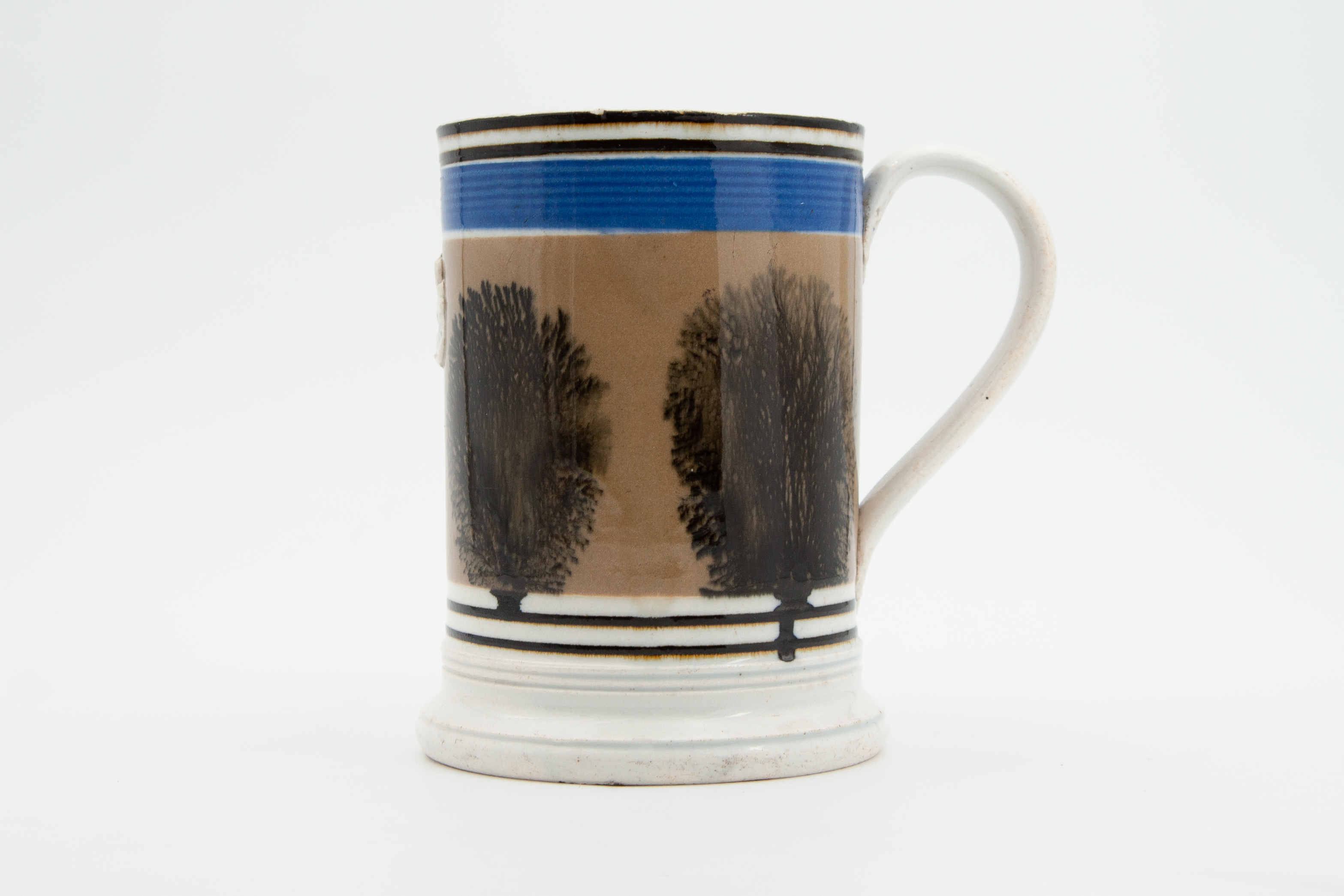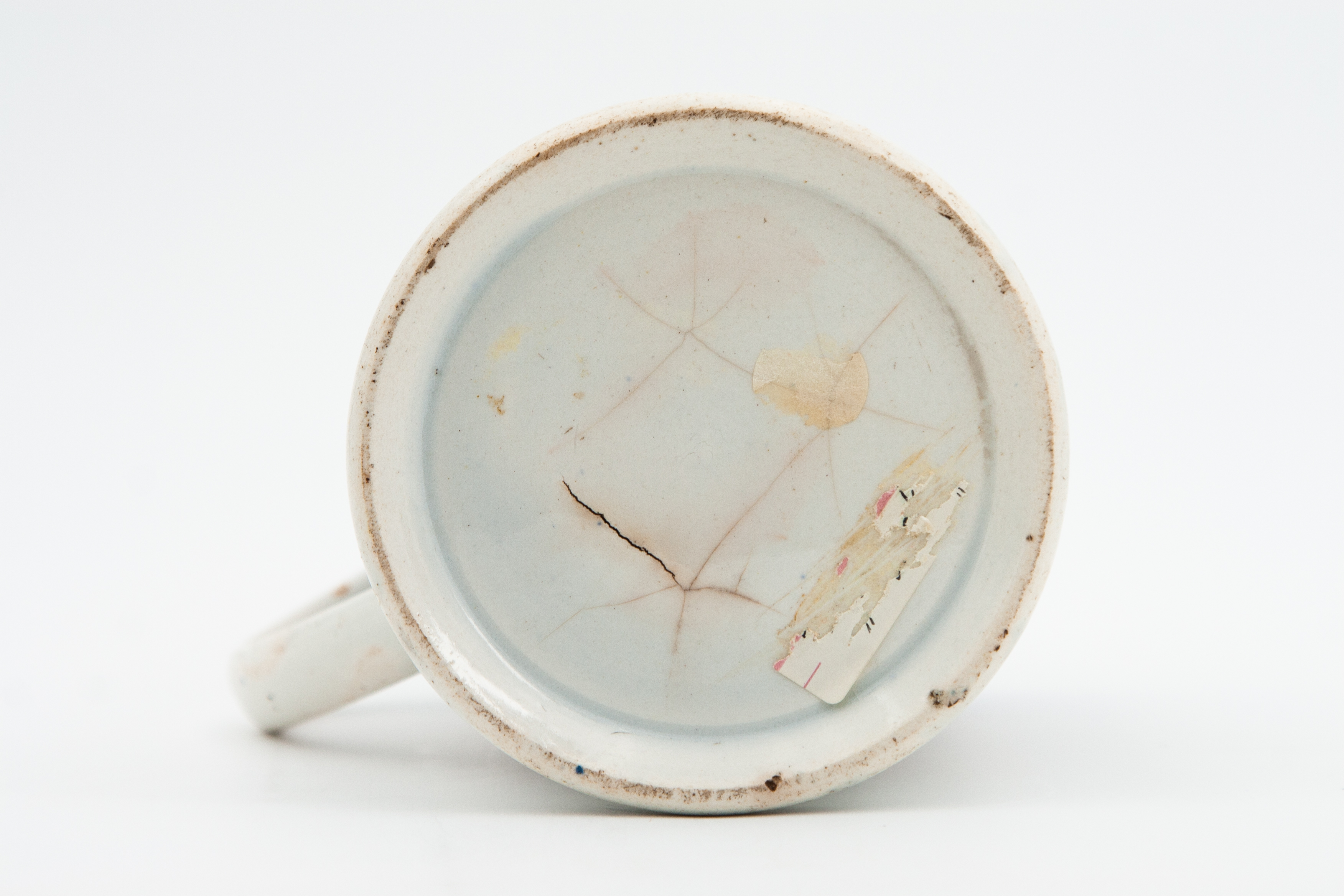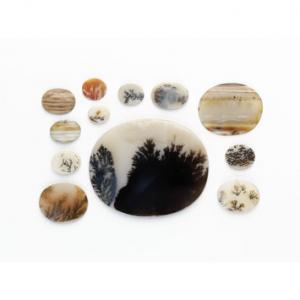This large English mochaware mug features rouletted bands of black and blue framing a tree-like pattern (referred to as “algae” or “dendrite”) on a taupe brown background. The handle has acanthus leaf terminals. A central molded emblem reads “Imperial” and refers to the mug’s capacity for an Imperial Quart – of beer. Indeed, mochaware pieces such as this were used as bar wares in England in the late 18th and early 19th centuries. Because of their original usage in bars and pubs, mochaware and other dipped wares rarely survive today. You can imagine that many were broken after a particularly long day or a night of revelry!
This large English mochaware mug features rouletted bands of black and blue framing a tree-like pattern (referred to as “algae” or “dendrite”) on a taupe brown background. The handle has acanthus leaf terminals. A central molded emblem reads “Imperial” and refers to the mug’s capacity for an Imperial Quart – of beer. Indeed, mochaware pieces such as this were used as bar wares in England in the late 18th and early 19th centuries. Because of their original usage in bars and pubs, mochaware and other dipped wares rarely survive today. You can imagine that many were broken after a particularly long day or a night of revelry!
Essay
“…in my opinion beer tastes better out of china.”
-George Orwell, “The Moon Under Water,” Evening Standard, 9 February 1946
Developed in Staffordshire in the late 18th century, mocha- and dipped wares utilized colored liquid clay slips to create abstract and geometric motifs. Mocha- and dipped wares were rather quotidien in the first half of the 19th century, being used primarily in bar and pub settings. However, they exhibit an innovative and scientific artistic process as well as the influence of a global economy.
Although mochaware was produced cheaply for consumption in bars, it demonstrates an interesting coalescence of industry and artistry. Mochaware was developed and produced in Staffordshire, England in the midst of the Industrial Revolution, a period which saw a decrease in agrarian-based economies and an increase in urbanization that led to the rise of factories and mass-production. Creation processes previously undertaken by artists and craftsmen passed to factory workers, who worked to turn out hundreds of pieces daily to supply market demands. Mochaware represents this transition: a melding of Industrial Revolution mechanization and the previous generation of pure craftsmanship.
Mochaware vessels came in standardized sizes and were produced using molds. This mug, with its Imperial Quart emblem, is a particularly good example of this. In 1824, Great Britain adopted the Imperial System to create official units of measurement. Vessels had to be produced precisely to the government-mandated standards. Machine-produced molds ensured that accuracy. Another mechanized element of this mug can be seen in the engine-turned elements in the rouletted bands of black and blue around the rim and near the bottom. Engine-turning, which can be found on pottery as early as the 1770s, was a process that was used to create complex and exact geometric designs.
After the vessels were formed and dried, an artist would hand paint the unique designs. The dendrite pattern on this mug was created using the chemical reaction between an acidic “mocha tea” and basic alkaline slip. The potter first coated the mug with a taupe slip. Then, he held the mug upside down and touched the slip with a brush dipped in a “mocha tea,” which contained an acidic solution of ingredients such as tobacco juice, hops, ground iron scale, and even urine. The “tea” would react with the slip and spread into a tree-like design. While the artist chose his colors and placement of designs, he did not have absolute control over the final design. A sense of randomness prevails in these wares, and no two are alike, making each a unique artistic work.
Today the term “mochaware” is widely used to encompass all types of dipped wares, however only pieces with the dendritic decoration seen here were called “mocha” by the original craftsmen and retailers. Herein lies part of mochaware’s surprisingly global connection and impact. “Mocha” is the English translation of al Makha, a bustling port city in Yemen. During the late eighteenth and early nineteenth centuries, al Makha was known for its moss agate trade, a stone whose treelike pattern inspired the very same on English dipped pottery. Interestingly enough, al Makha also had a flourishing coffee trade in Mocha beans from the 15th through the 18th centuries, which is where today’s mocha coffee gets its name. Moss agates were mined in India, then exported to England by the British East India Company through the al Makha port. In England they were used in jewelry as semi-precious stones, and as sources of artistic inspiration for the Staffordshire potters. Mochaware pottery was exported in great numbers to the United States, and American artisans in turn produced their own mocha pieces. Moss agates themselves were also exported from England to France and prized by members of the aristocracy and court. As in England, the stones inspired French potters to create their own mochaware pottery.
Mochaware’s artistry and global impact is interesting to think about in juxtaposition with its original consumers. According to ceramics scholar George L. Miller, mocha- and dipped wares were the cheapest decorated hollow wares available on the market in the late 18th and 19th centuries (Miller 1991). At the inception of their production in the 1780s, these pieces cost 60% more than undecorated wares (likely due to novelty and a nebulous manufacturing process). By the mid-19th century, however, prices dropped to only 8% more than their plain counterparts. A decrease in prices makes sense: as the Industrial Revolution continued, production processes became increasingly concrete and automated. Because of their inexpensive price, mochawares were often used in bars, where the rate of breakage was likely quite high, and a diminished supply could be restocked rather inexpensively. These bars were primarily the destinations of the working class, likely including the very artisans who worked in the potteries that produced the vessels.
Though not perceived of as “exotic” objects of prestige in the same way as Chinese export porcelain or even Neoclassical ceramics were, mochaware inherently holds the impact of trade and global inspiration as well as new artistic innovations and ways of manufacturing.
BT
Condition
The mug is in very good condition, with three minor star-shaped cracks on the bottom. This type of crack is prevalent in English mochaware.
For a detailed condition report, please contact us.
Provenance
Hindman Auctions
Christa’s Ltd. Chicago, IL
References
Carpentier, Donald and Jonathan Rickard. “Slip Decoration in the Age of Industrialization.” Ceramics in America, ed. Robert Hunter. Burlington: University of Vermont Press, 2001.
Miller, George L. “A Revised set of CC Index Values for Classification and Economic Scaling of English Ceramics from 1787 to 1880,” Historical Archaeology, Vol 25, no. 1 (1991): 1-25.
Rickard, Jonathan. Mocha and Related Dipped Wares, 1770-1939. University Press of New England, 2006.
Cited Works
“…in my opinion beer tastes better out of china.”
-George Orwell, “The Moon Under Water,” Evening Standard, 9 February 1946
Developed in Staffordshire in the late 18th century, mocha- and dipped wares utilized colored liquid clay slips to create abstract and geometric motifs. Mocha- and dipped wares were rather quotidien in the first half of the 19th century, being used primarily in bar and pub settings. However, they exhibit an innovative and scientific artistic process as well as the influence of a global economy.
Although mochaware was produced cheaply for consumption in bars, it demonstrates an interesting coalescence of industry and artistry. Mochaware was developed and produced in Staffordshire, England in the midst of the Industrial Revolution, a period which saw a decrease in agrarian-based economies and an increase in urbanization that led to the rise of factories and mass-production. Creation processes previously undertaken by artists and craftsmen passed to factory workers, who worked to turn out hundreds of pieces daily to supply market demands. Mochaware represents this transition: a melding of Industrial Revolution mechanization and the previous generation of pure craftsmanship.
Mochaware vessels came in standardized sizes and were produced using molds. This mug, with its Imperial Quart emblem, is a particularly good example of this. In 1824, Great Britain adopted the Imperial System to create official units of measurement. Vessels had to be produced precisely to the government-mandated standards. Machine-produced molds ensured that accuracy. Another mechanized element of this mug can be seen in the engine-turned elements in the rouletted bands of black and blue around the rim and near the bottom. Engine-turning, which can be found on pottery as early as the 1770s, was a process that was used to create complex and exact geometric designs.
After the vessels were formed and dried, an artist would hand paint the unique designs. The dendrite pattern on this mug was created using the chemical reaction between an acidic “mocha tea” and basic alkaline slip. The potter first coated the mug with a taupe slip. Then, he held the mug upside down and touched the slip with a brush dipped in a “mocha tea,” which contained an acidic solution of ingredients such as tobacco juice, hops, ground iron scale, and even urine. The “tea” would react with the slip and spread into a tree-like design. While the artist chose his colors and placement of designs, he did not have absolute control over the final design. A sense of randomness prevails in these wares, and no two are alike, making each a unique artistic work.
Today the term “mochaware” is widely used to encompass all types of dipped wares, however only pieces with the dendritic decoration seen here were called “mocha” by the original craftsmen and retailers. Herein lies part of mochaware’s surprisingly global connection and impact. “Mocha” is the English translation of al Makha, a bustling port city in Yemen. During the late eighteenth and early nineteenth centuries, al Makha was known for its moss agate trade, a stone whose treelike pattern inspired the very same on English dipped pottery. Interestingly enough, al Makha also had a flourishing coffee trade in Mocha beans from the 15th through the 18th centuries, which is where today’s mocha coffee gets its name. Moss agates were mined in India, then exported to England by the British East India Company through the al Makha port. In England they were used in jewelry as semi-precious stones, and as sources of artistic inspiration for the Staffordshire potters. Mochaware pottery was exported in great numbers to the United States, and American artisans in turn produced their own mocha pieces. Moss agates themselves were also exported from England to France and prized by members of the aristocracy and court. As in England, the stones inspired French potters to create their own mochaware pottery.
Mochaware’s artistry and global impact is interesting to think about in juxtaposition with its original consumers. According to ceramics scholar George L. Miller, mocha- and dipped wares were the cheapest decorated hollow wares available on the market in the late 18th and 19th centuries (Miller 1991). At the inception of their production in the 1780s, these pieces cost 60% more than undecorated wares (likely due to novelty and a nebulous manufacturing process). By the mid-19th century, however, prices dropped to only 8% more than their plain counterparts. A decrease in prices makes sense: as the Industrial Revolution continued, production processes became increasingly concrete and automated. Because of their inexpensive price, mochawares were often used in bars, where the rate of breakage was likely quite high, and a diminished supply could be restocked rather inexpensively. These bars were primarily the destinations of the working class, likely including the very artisans who worked in the potteries that produced the vessels.
Though not perceived of as “exotic” objects of prestige in the same way as Chinese export porcelain or even Neoclassical ceramics were, mochaware inherently holds the impact of trade and global inspiration as well as new artistic innovations and ways of manufacturing.
BT
The mug is in very good condition, with three minor star-shaped cracks on the bottom. This type of crack is prevalent in English mochaware.
For a detailed condition report, please contact us.
Hindman Auctions
Christa’s Ltd. Chicago, IL
Carpentier, Donald and Jonathan Rickard. “Slip Decoration in the Age of Industrialization.” Ceramics in America, ed. Robert Hunter. Burlington: University of Vermont Press, 2001.
Miller, George L. “A Revised set of CC Index Values for Classification and Economic Scaling of English Ceramics from 1787 to 1880,” Historical Archaeology, Vol 25, no. 1 (1991): 1-25.
Rickard, Jonathan. Mocha and Related Dipped Wares, 1770-1939. University Press of New England, 2006.
This item ships free to the continental US, and globally for a flat-rate fee of $50.
All objects are packed with utmost care by our team of expert fine art shippers. All items are shipped with parcel insurance.
For more information on our shipping policies, please visit our FAQ Page.


